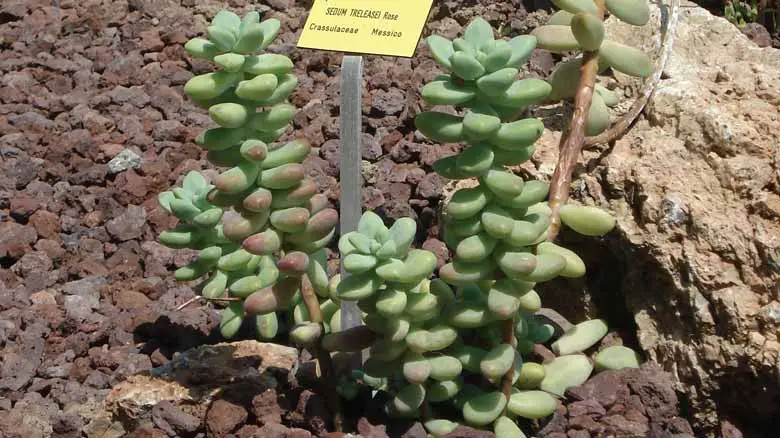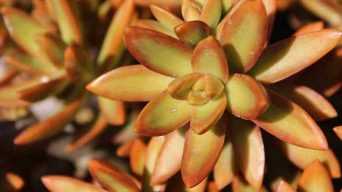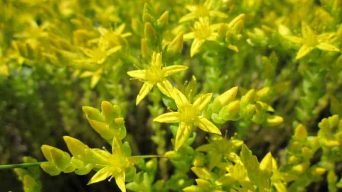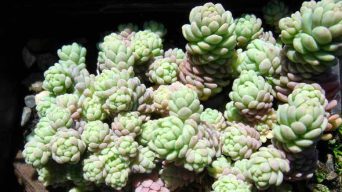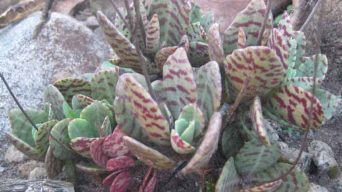The Sedum Treleasei succulent plant is a beautiful and easy to grow plant that does not require much care.
However, many people are still unsure of how to take care of it properly.
This guide will show you how to propagate the Sedum and give it the best chance at thriving in your home.
If you’re looking for a new houseplant or want more information about caring for sedums, read on!
About the Sedum Treleasei Succulent Plant
The Sedum Treleasei is a member of the Sedum family and belongs to the sub-genus Hylotelephium.
Its name comes from Thomas Lincoln Trelease, an American botanist. He first discovered this type of Sedum in Southern Texas while studying plants for his doctoral degree.
The Sedum Treleasei can be found growing on dry hillsides or rocks located mostly south of Dallas County and east of Bandera County in Texas and Coahuila State in Mexico.
It has been labeled an endangered species due to its restricted range, but luckily you can easily grow one at home!
The Sedum Treleasei can grow in full sun to partial shade. It is an easy plant to care for and propagate, one of the reasons it is so popular among gardeners all over the world.
The Sedum Treleasei reaches a height of one foot. It has yellow, star-shaped flowers that bloom from winter to springtime. Its foliage is green and small, with a tough texture.
Sedums are known as succulents because they store water inside their stems and leaves, making them perfect plants for desert environments where there is often not enough rainfall.
In addition, this type of Sedum does well indoors since it doesn’t require direct sunlight but will still bloom beautifully.
How To Care for Sedum Treleasei
Sun Exposure & Light Requirements
Succulents are a pretty hardy plant, and the Sedum treleasei is no exception. It will grow in light that ranges from full sun to partial shade.
However, they need more sunlight than other succulent plants do because of their compact shape.
To ensure your Sedum Treleasei gets enough bright light, plant it near a window facing east or on a porch facing south. This way, they will get indirect sunlight all day long.
You must be careful not to move these succulents around from place to place, as they require some time to adjust. Generally, it is best for them to leave the Sedum treleasei in one pot and let it grow there until it has established itself.
It also does well when planted outdoors in hardiness zones three through nine.
However, keep an eye on its light requirements because stronger sunlight can cause bleaching of the leaves or sunburned spots that will never fully heal.
Watering
Water your Sedum sparingly. The succulent does not tolerate over-watering well and will rot if too much water is left in the soil for an extended period.
Water potted plants when the top inch or so feels dry to the touch, but be careful not to overwater them by giving too much at once. It’s better to give less often than more frequently.
Add some mulch around pot edges that are higher up off ground level where rainfall may not reach as easily, such as pots on a patio or deck railing.
Mulching also helps retain moisture in soils with high clay content, which can suck available nutrients out of plant roots faster than it would like without adequate drainage.
Soil Requirements
The soil for Sedum Treleasei should be a well-draining cactus and succulent soil.
The soil should be made of sand, peat moss, or some other material that drains well. You do not want to use a regular potting mix for this succulent plant, as it will not drain correctly.
To help the drainage process, you can add perlite. This white porous volcanic rock does an excellent job of improving aeration in heavier soils. It retains water when there’s less than ideal drainage available.
As with most plants, the goal is to promote healthy root growth by simultaneously providing them with nutrients and air circulation.
Using sandy loam mixed with compost tends to work best because it allows for plenty of both! If your container has no holes, place gravel at the bottom to promote drainage.
Temperature and Humidity
They prefer temperatures between 40°F and 95°F with humidity levels below 60%. Still, they can tolerate higher temps (upwards of 100 ° F) for a short time.
They won’t tolerate any frost or freezing temperatures. So if outside temps drop to below 40 degrees Fahrenheit, keep your plant inside until winter has passed, or it will die from cold weather exposure.
A good rule of thumb to follow is that any time you see visible frost on plants outside (upwards towards 100 ° F) or if you notice frost on your windows, bring them inside.
Fertilizing Sedum Treleasei
Sedums are a hardy group of plants that can withstand periods with little water. So it is not necessary to fertilize them often.
If you over-fertilize your sedum plants, they will grow unevenly. The fertilizer will only help shoots grow close to where it was applied. That means that the new growths on top will grow faster than the older leaves below.
A light application every two weeks should be sufficient for most cultivars in pots or hanging baskets.
You may need to add more fertilizer during the blooming season, as this is when your sedums put down their roots.
However, please do not use an excessive amount. It may burn your plant’s root system, which could lead to the death of some or all of its parts.
Potting and Repotting Sedum Treleasei Succulent
When you are ready to pot your Sedum Treleasei plant, make sure that the new container has plenty of drainage holes.
Succulents do not like waterlogged soil, and too many plants living in one small pot can lead to rot.
When planting a succulent into a larger container, make sure that the soil is firmly around and covering the roots.
Make sure not to overwater when repotting sedums or any other type of succulents because they will quickly rot if there isn’t enough airflow through their leaves.
These types of plants thrive on dryness, so it’s important to remember this while watering them even after repotting.
It’s important to remember that sedum plants are very slow growers, so be patient when you’re waiting for your succulent to recover from repotting.
The plant can take months or even years to get back into shape after being uprooted and replanted in a new container.
It’s best to repot every couple of years when the Sedum starts getting too big for its pot. This is also an excellent time to divide plants that are beginning to crowd out because they get so close together.
If you’re going to divide a Sedum, be sure to carefully excavate the plant to damage any of the healthy roots, which may cause it to rot and die.
Divide plants by pulling them apart with their root ball intact using your hands and then cover soil back over them until they look just like before they were divided up.
You can also use fertilizers on sedums during the repotting season because this will give new life to the flowers starting to wilt after being replanted in fresh potting soil.
Pruning
Pruning is the process of removing dead, diseased, or damaged parts from a plant.
The goal in pruning sedums is to be more selective about which shoots are removed and where they are trimmed back so that you can direct new growth into desired areas.
These plants grow rapidly as long as their roots remain moist but become stressed when too much foliage rots on top and dies off below ground level.
To prune a Sedum Treleasei plant:
- The first step would be trimming away any wilted leaves lower than half an inch from the soil line (too many rotting leaves will cause root rot).
- Next, you should remove the flower stalks that have grown on your plant. This will make the plant produce more leaves and stems but not create more flowers.
- Afterward, make sure to remove any branches that are growing from the middle of the plant. These will be stunted and may show a disease. Also, this will help make branches at different heights.
Pests and Diseases
While Sedum is considered a slow-growing succulent, it may be susceptible to pests and diseases.
When you first receive your plant, inspect the leaves carefully for any signs of damage or infestation by aphids, spider mites, or mealy bugs.
If any are present, take appropriate action:
- Wash the plant off with a hose.
- Spray it down with neem oil or insecticidal soap spray to kill any aphids, spider mites, and mealybugs.
- Monitor for another month for new infestations on your Sedum treleasei succulent plants. Check leaves daily, remove insects when they are spotted, and spray again if necessary.
If you notice a white powdery residue on your Sedum’s roots or stems, this could indicate that fungus is present in the soil.
Make sure to inspect carefully before watering to avoid spreading this disease throughout your garden!
It’s also wise to quarantine new additions before adding them in with established plants. They could harbor pest eggs that will later affect other plants without warning.
It can also be attacked by bacterial infections such as botrytis blight which causes the leaves to turn black and fall off.
When this happens, remove all affected plants from the garden and uproot them to avoid spreading this disease.
If you’re unsure what is ailing your Sedum, isolate it in an area where no other succulents are growing. So that if its unhealthy roots were to spread infection into surrounding plants, they would be easily found.
How To Propagate Sedum Treleasei Succulent
Propagating sedum plants is simple. By taking a cutting or division from the plant, you can create more of this succulent in your own home.
There are two methods: stem cuttings and leaf cuttings.
Stem cuttings will produce offsets that grow close to the mother plant. Therefore, they make great additions as a ground cover around other plants.
Leaf cuttings need some time to establish before their new roots take hold, but they do well in less-than-ideal conditions while rooting themselves out.
Stem Cuttings
Stem cuttings can be taken from the mother plant or another healthy stem cutting. The best time to take a stem cutting is in early spring (March and April) when new growth emerges after winter dormancy. Still, they can also be done at other times of the year if desired.
- First, cut the stem just below a leaf node. You will find new growth sprouting out the second set of leaves.
- Next, place the cutting in a well-draining soil material such as perlite or vermiculite and keep it moist until rooting has begun. This can take anywhere between one to two weeks, depending on what time of year your cutting was taken from and how often you water it.
- Rooting hormone can be applied if desired, but this isn’t necessary for most plants.
- The newly rooted plant should then be transplanted into a potting medium that drains easily at an appropriate size container.
- Check the plant every day and water it as necessary until it is established in its new pot.
Leaf Cuttings
Cutting leaves from your sedum plants can be a great way to propagate them.
Here are the steps for leaf-cutting:
- Take a small cutting of leaves from the plant and place it in a cup filled with moist potting soil.
- Water your plants up to an inch or two below the surface of the soil, but do not leave water covering the top.
- Place this into direct sunlight indoors for at least four weeks before transplanting outside to sustain growth when transplanted outdoors later on.
The only downside of this method is the time it takes before you see any progress from your plant cuttings.
However, patience will be rewarded with a new batch of beautiful succulent plants!
Is the Sedum Treleasei Toxic?
The Sedum Treleasei plant is not toxic to humans, pets, and other animals. However, it will take a lot of eating for any type of animal to have an unhealthy reaction to be used as a non-toxic deterrent against herbivores in gardens and other places.
The plant contains diterpenoid compounds that are soluble in water but cannot leach out into the soil and accumulate over time, like the toxins found on most plants.
These chemicals may produce some level of irritation if ingested orally by humans. However, this has never been confirmed experimentally with Sedum Treleasei specifically.
In general, sedums should be handled carefully because they bruise easily, which causes them to lose moisture and nutrients faster than when left undamaged.
There’s also the potential for them to be contaminated with bacteria and other microbes.
Final Thoughts
Sedum Treleasei plants are beautiful succulents that make great additions to any garden.
Taking care of them may seem easy at first, but there is a lot more involved than you might think!
It’s best to be informed and educated so your Sedum plant thrives in the long run.

